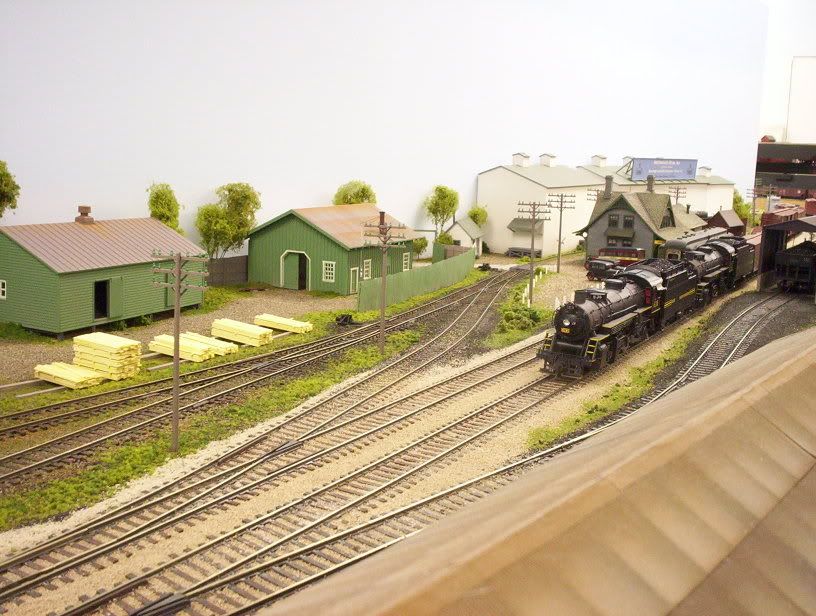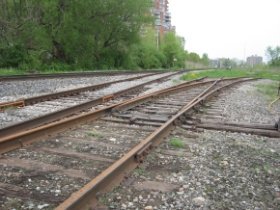From main line to neglected industrial spur
- Thread starter Biased turkey
- Start date
You are using an out of date browser. It may not display this or other websites correctly.
You should upgrade or use an alternative browser.
You should upgrade or use an alternative browser.
I use door shims from the hardware store. Just cut the thick end the same height as the roadbed and you have your taper. Sorry I don't have a picture right now.
Loren
Loren
Where my track has roadbed under it, I use cork. Where I want to run an industrial siding off the main line, I lay the cork partway into the siding too: if you have room, the farther the better. I glue it in place using yellow carpenters' glue, then use 1 1/2" nails, tapped in just far enough to bite into the plywood subroadbed, to hold it in place until the glue dries. (overnight) After removing the nails, I use very coarse sandpaper (#36 garnet), wrapped around a small block of wood, to taper the cork from full thickness just beyond the end of the diverging rails of the turnout, down to nothing at the end. The reason for laying cork as far into the siding as possible is to keep the transition from the mainline down to "ground level" as gradual as possible. The sanding, even if the transition is 2' or 3' long, takes only a few minutes to do. Save the sanding residue, as it's useful as scenic fill elsewhere on the layout. If you don't have a lot of room for the transition, as long as the grade is not so abrupt as to cause cars to uncouple, you should be alright.
In the photo below, the double main lines are on cork, while the industrial trackage, both near the lumber piles and at the rear, between the station and the icehouse, are all right on the plywood subroadbed. The transition down begins just past the guardrails on the turnout near the telegraph pole, and ends just before the guardrails of the turnout which is near the road crossing. In other words, the turnout off the mainline is completely at the same level as the mainline, and the turnout near the road crossing is completely at the same level as the subroadbed. The transition between the two is accomplished in a stretch of track about 15" long.

On my layout, I extend the mainline ballast out onto the diverging route of the turnout, gradually increasing the proportion of cinder sub-fill as the track gets farther away from the main. I also begin to mix in some earth-coloured ground foam, different colours and textures of ballast, and, of course, some ground foam weeds. I like to use very fine green or yellow foam to begin a subtle colour transition to areas with heavier concentrations of "weeds". On an industrial siding, the ballast might be almost non-existant, with most of the ties covered with "dirt", and generous amounts of weeds growing between them.
Wayne
In the photo below, the double main lines are on cork, while the industrial trackage, both near the lumber piles and at the rear, between the station and the icehouse, are all right on the plywood subroadbed. The transition down begins just past the guardrails on the turnout near the telegraph pole, and ends just before the guardrails of the turnout which is near the road crossing. In other words, the turnout off the mainline is completely at the same level as the mainline, and the turnout near the road crossing is completely at the same level as the subroadbed. The transition between the two is accomplished in a stretch of track about 15" long.

On my layout, I extend the mainline ballast out onto the diverging route of the turnout, gradually increasing the proportion of cinder sub-fill as the track gets farther away from the main. I also begin to mix in some earth-coloured ground foam, different colours and textures of ballast, and, of course, some ground foam weeds. I like to use very fine green or yellow foam to begin a subtle colour transition to areas with heavier concentrations of "weeds". On an industrial siding, the ballast might be almost non-existant, with most of the ties covered with "dirt", and generous amounts of weeds growing between them.
Wayne
If you are using flex track, the track will bend into a transitioned vertical curve if allowed to drop from the level of the roadbed to table top naturally. The main thing to remember is to keep the turnout well supported so that you don't get any twist in the switch, then support the first few inches of track coming off the switch so that it doesn't have a chance to make an untransitioned vertical curve at the rail joiners.
Depending on your benchwork, you could cut along the sub-roadbed for the siding and drop the end of this the quarter-inch (or whatever) of the roadbed thickness, until the end of the roadbed lines with the sub-roadbed. This will let you get a nice transition to and from the grade.
Thanks to all the nice people who took some of their precious time to reply.
To grewsome: I like the idea of using a door shim but in my case it'll be difficult because the "transition sectional track is a 9 3/4" radius curve and I don't feel like "carving" that door shim to match the curve. If the transition track was straight I might have adopted your idea.
To doctorwayne: My 1st idea was to tapper the cork roadbed but before gluing it to the pink styrene foam, but now I realize that it'll be easier if I glue the roadbed then sand it the way you suggest.
To Russ Bellinis: As mentioned to grewsome, the planned transition track is a curved sectional track but I have 3 sections of Atlas Flextrack I purchased for practicing. It'll be a good opportunity for me to practice Flextrack laying just for a small portion of my tiny N scale layout.
To 60103: Another wise option you suggest here.
Decisions, decisions.
To grewsome: I like the idea of using a door shim but in my case it'll be difficult because the "transition sectional track is a 9 3/4" radius curve and I don't feel like "carving" that door shim to match the curve. If the transition track was straight I might have adopted your idea.
To doctorwayne: My 1st idea was to tapper the cork roadbed but before gluing it to the pink styrene foam, but now I realize that it'll be easier if I glue the roadbed then sand it the way you suggest.
To Russ Bellinis: As mentioned to grewsome, the planned transition track is a curved sectional track but I have 3 sections of Atlas Flextrack I purchased for practicing. It'll be a good opportunity for me to practice Flextrack laying just for a small portion of my tiny N scale layout.
To 60103: Another wise option you suggest here.
Decisions, decisions.


